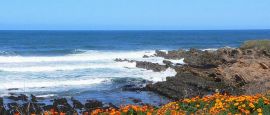California Weather, climate and geography
Weather & climate
Summers are very warm, with cool evenings, while the spring and autumn months are mild, with cool evenings. The winter 'rainy season' is gentle and occurs between January and March. Much of the state has a Mediterranean climate, with hot, dry summers and mild, rainy winters. San Francisco is known for its characteristic fog in spring and early summer. Northern California and the high mountains have snow in winter, while the deserts experience very hot summers and mild winters.
For the best skiing in Lake Tahoe, the end of January and the beginning of February offer good snow and a break from the swelling crowds at Christmas and through mid-January. For prime sunny beach weather in Southern California, July and August offer lots of sun and heat, but there will be crowds. Avoid the “May Gray” and “June Gloom,” which bring a low-lying marine layer of clouds over the coastline for most of the day.
Lightweight during the summer with warmer wear for the cooler winter period. Hiking boots and gear are needed for more adventurous mountain climbing and hiking in Yosemite and parts of Joshua Tree. Skiing in Lake Tahoe is warmer than most mountains, so dress in layers, and don’t be surprised to see skiers show-off in t-shirts.
Beachwear is acceptable in restaurants and shops near the beach, but shirts and shoes are required by law. Men should not wear shorts away from the beach. Los Angeles is a fashion-conscious city, especially for women and dressier clothes are required for many nightclubs and restaurants. Men don’t have to wear formal suits, but shirts and trousers are standard.
Geography
California is a geographically diverse area of the USA. The state is usually divided into Northern and Southern California, though there are isn’t a well defined boundary. San Francisco is a northern city, while San Diego and Los Angeles are southern, but the areas in between aren’t easily defined – rather, the distinction is more between the differing attitudes and lifestyles in different areas, than a physical boundary. Southern California is generally a developed urban environment, with major cities and sprawling suburbs accessible only by car. Northern California is more rugged and natural, with vineyards, mountains, and agricultural regions.
California is bordered to the north by Oregon state, to the east by the states of Nevada and Arizona across the Colorado River, to the south by Mexico, and to the west by the Pacific Ocean. Earth scientists have divided the state into eleven distinct mountain ranges, plateaus, deserts, basins, and valleys. The most notable mountains are the Sierra Nevada range which run north-south for 640 km (398 miles) and contain the highest peak in the United States: Mount Whitney. The Mojave Desert contains the lowest and hottest place in America: Death Valley, where the temperatures hover around 49°C (120°F). in mid-summer. Earthquakes are a regular (but rarely deadly) occurrence throughout the state, especially near San Francisco.
Do you have any Feedback about this page?
© 2025 Columbus Travel Media Ltd. All rights reserved. No part of this site may be reproduced without our written permission, click here for information on Columbus Content Solutions.





 You know where
You know where